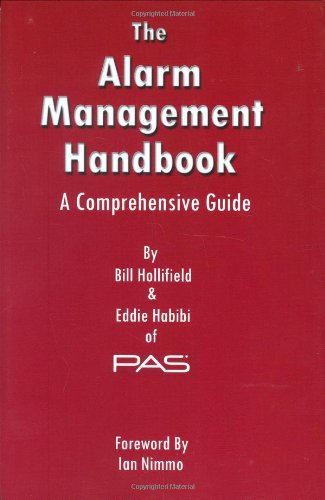

The Alarm Management Handbook
D**D
A Must for Control Engineers
If this book is not on your shelf and you've been told to cut down on the nuisance alarms or else --- start looking for a new job!As a process engineer who has been involved, off-and-on, with controls, I found this book refreshing. This is a how-to-book! Although the trade magazines have turned to the subject of how too many alarms are a safety hazard, you won't find the details there. This book is chocked full of useful examples, which should provide ammunition for those of us who dealt with sticky accountants. It should be required reading for process engineers who seem to enjoy loading graphics with whirling, buzzing displays. I worked with one guy who quickly found ways to load the DCS --- we went from 40% to 60% usage after some of his graphics were loaded. It was a great ego boost for him but I remember the poor engineer who was sizing a bigger DCS. As an old-timer, I cherish the humor throughout the book. The chapter entitled, "The Death of the Lightbox," was amusing to those of us who grew up on the now infamous mimic board.There is way too much good advice to mention here but here's an example of note:"Assume that you have 2,000 alarmable points on a console, a typical, perhaps slightly low amount. Each point can generally have more than one alarm. We have identified that you will probably have 4-6 people in the room during the D&R (documentation and rationalization} at a significant cost. If you are very experienced in performing a D&R, and are very well prepared, you can average about 100 points per day. Thus you will need 20 days of conference room time, adding up to about 100 person-days." The authors go on to suggest some short-cuts such as:* lump together duplicate facilities or systems, or even similar controls;* hire an experienced D&R facilitator the first time;* stave off war-stories* develop generic corrective actions such as "troubleshoot to determine exact problem;"* avoid obvious corrective actions such as for low flow: open valve;* capture only useful bullet items in causes and consequencesThe authors also present their own patented D&R technique.This method could reduce conference time by 50%.Following the principles developed in this handbook should permit you to identify alarm problems, develop a common-sense alarm philosophy, and reduce DCS usage.If this review was helpful, please vote.
C**K
How to make alarm management interesting!
If your automation system is creating alarms that do not require an immediate response, then you need this book. How do you define an immediate response you might ask? If the alarm is something that needs response within minutes as opposed to hours or days, that is immediate. A really good read, we've followed some of the recommendations and have made our alarm system "useful" again.
Y**I
Fantastic guide to managing alarms.
If you are drowning in a sea of nuisance and useless alarms from your controls alarming systems, this book will lay out how you build a boat and stay above it all.
J**S
Four Stars
Is exact that i need
Trustpilot
1 month ago
1 week ago